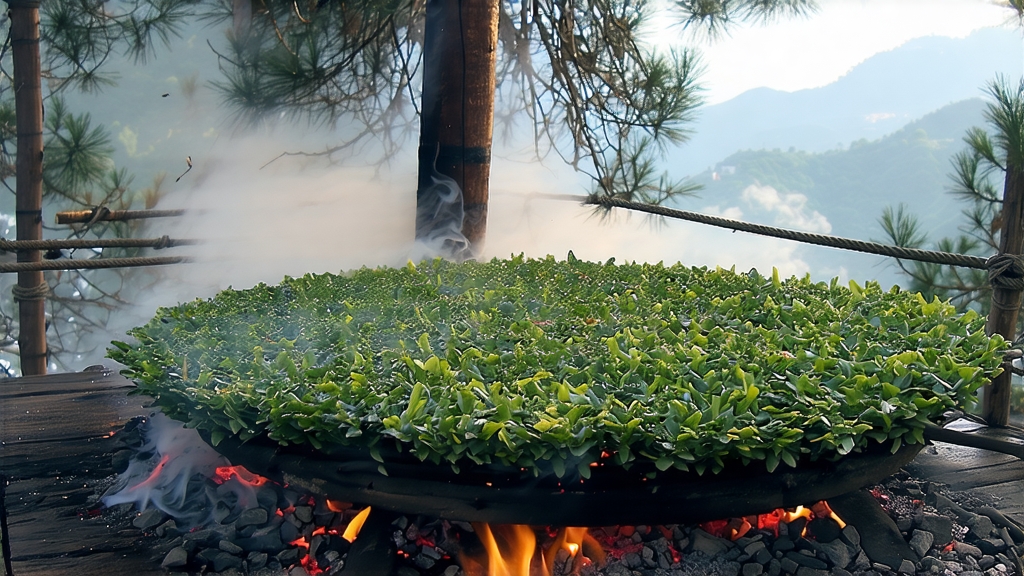
Few teas ignite the Western imagination as fiercely as Lapsang Souchong. Mention it in a London tearoom or a Brooklyn café and the reply is almost Pavlovian: “Ah, the smoky one!” Yet behind the evocative aroma lies a 400-year-old saga of military urgency, Ming-dynalty ingenuity, and terroir so specific that moving the pine wood a single valley over alters the cup forever. This article invites the global tea traveler to look past the perfume of campfire and discover why the original Zheng Shan Xiao Zhong from Tongmu Guan remains the untamed heart of Chinese black tea.
-
Birth in the Wuyi Fortress
The Wuyi massif of northern Fujian has always been a refuge for rebels and monks, its basalt cliffs dripping with orchids and mist. In 1646 Qing troops descended the passes, forcing tea makers to flee. To dry the freshly rolled leaves before the soldiers arrived, farmers improvised with fresh pine boughs, firing the tea in haste. The accidental smoke infusion not only preserved the leaf but also created a flavor so novel that Dutch traders in Xiamen paid triple the usual price. Thus “bohea” (the Fujianese pronunciation of Wuyi) conquered Europe two decades before Assam was even planted. -
Two Families, One Name
Today “Lapsang Souchong” is used indiscriminately, yet connoisseurs distinguish two bloodlines.
• Zheng Shan Xiao Zhong (Original Mountain Small Leaf): grown inside the 600–1,200 m core zone of Tongmu Guan, National Nature Reserve. Only indigenous C. sinensis var. bohea bushes propagated by seed are permitted; pesticides are banned; and the pine must be Masson or Chinese red pine indigenous to the gorge. Daily output is under 500 kg, 80 % consumed domestically by China’s elite.
• Wa Shan Xiao Zhong (Outer Mountain): leaf from neighboring counties or even Yunnan, smoked or merely scented with pine essence. These bulk teas supply the Russian caravan blends and flavored sachets found in supermarkets. The difference is as stark as Grand Cru Burgundy against boxed wine. -
Leaf Architecture
True Tongmu leaf is surprisingly tiny—”souchong” refers to the fourth and fifth leaves down the shoot, after pekoe and orange pekoe. The oval blades are thick, anthocyanin-tinted on the underside, and rich in terpene precursors that bond with pine resin during firing. Plucking occurs only between Qingming and Grain Rain, when spring mists moderate UV and keep L-theanine levels high. -
Crafting Smoke with Precision
Withering: Bamboo trays are set above ground-level channels where pine embers smolder at 40 °C for 8–10 h. The leaf loses 60 % moisture while absorbing α-pinene and longifolene vapors.
Rolling: A 45-min rotary press ruptures cells without overheating; the goal is a tight strip that will trap aromatics.
Oxidation: In cedar-lined chests the leaf rests 3 h at 26 °C, turning mahogany. Enzymes convert catechins into theaflavins, balancing tannic grip against forthcoming resin.
Pan-firing: Woks at 180 °C halt oxidation in 3 min; masters listen for the “pop” of residual water.
Smoke-finishing: The decisive act. A two-tier oven: top tier holds tea in rattan baskets, bottom tier burns pine logs that were soaked overnight to resinous perfection. Temperature oscillates between 70 °C and 90 °C for 6–8 h while craftsmen shuffle baskets every 20 min so that no leaf scorches. The finished tea carries 2–3 % moisture and a phenolic smoke index of 4.5–6.0 ppm—enough to perfume ten infusions yet not mask honeyed minerality. -
Grades & Vintage
Unlike most black teas, Lapsang Souchong improves for two years as pinewood esters polymerize, softening pungency into sandalwood and dried longan. Top grades are:
• Special Pine Needle: all tips, smoked only once, liquor the color of sherry.
• Reserve Charcoal: re-fired over bamboo charcoal in November, yielding cocoa and cigar box notes.
• Aged Tongmu 5-Year: stored in unglazed clay jars; smoky top-note recedes, replaced by camphor and dark honey